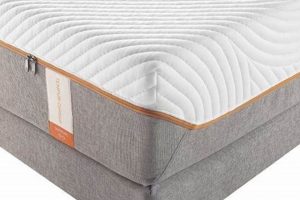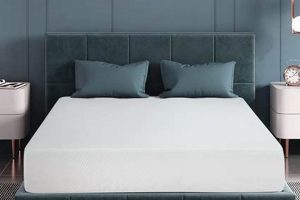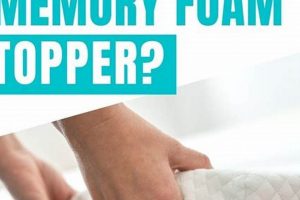This type of sleep surface integrates viscoelastic foam with gel particles. The foam conforms to the body’s shape, distributing weight evenly and reducing pressure points. The addition of gel is intended to regulate temperature, mitigating the heat retention often associated with traditional viscoelastic foam. This construction is frequently found in bedding designed for improved sleep comfort.
These products offer a balance of support and pressure relief, which can contribute to reduced pain and improved spinal alignment. The incorporation of gel seeks to address temperature concerns, leading to a more comfortable sleep experience. Historically, viscoelastic foam mattresses were recognized for their pressure-relieving qualities, but also criticized for their tendency to trap heat. The introduction of gel-infused options represents an evolution intended to address this drawback.
The following sections will delve deeper into the specific characteristics of these mattresses, including their construction, performance metrics related to temperature regulation and support, and considerations for selecting the optimal product based on individual needs and preferences. Different gel formulations, foam densities, and construction techniques influence the overall performance and durability. The subsequent analysis will provide a framework for understanding these variations and making informed purchasing decisions.
Guidance on Selection and Use
The following provides objective advice regarding the selection, care, and optimal use of products containing viscoelastic foam infused with gel. These guidelines are designed to maximize comfort and longevity.
Tip 1: Consider Density. Density impacts durability and support. Higher-density viscoelastic foam generally provides greater support and resists compression over time, but it may also retain more heat. Evaluate the density rating in relation to individual weight and sleeping preferences.
Tip 2: Assess Gel Type. Different types of gel infusions exist. Phase-change materials offer more effective temperature regulation than standard gel beads. Inquire about the specific gel type used and its cooling capabilities.
Tip 3: Evaluate Layer Construction. The arrangement of layers impacts overall performance. A thinner comfort layer may not provide adequate pressure relief for heavier individuals. Examine the layer composition and thickness to ensure sufficient cushioning.
Tip 4: Inspect the Cover Material. The cover material influences breathability and heat dissipation. Opt for covers made from natural fibers like cotton or bamboo, which promote airflow and reduce moisture buildup.
Tip 5: Utilize a Supportive Base. The foundation significantly affects the lifespan and performance. A solid, supportive base will prevent sagging and ensure even weight distribution. Consider using a platform bed frame or a compatible box spring.
Tip 6: Rotate Regularly. Regular rotation helps distribute wear evenly and prevents body impressions. Rotate the mattress every three to six months to prolong its lifespan.
Tip 7: Employ a Mattress Protector. A waterproof mattress protector safeguards against spills and stains, preventing damage to the foam. This will also help maintain a cleaner sleep surface.
Effective implementation of these recommendations leads to enhanced sleep quality, improved product longevity, and optimized value. Careful consideration of density, gel type, layer construction, and proper maintenance contributes to a superior sleep experience.
The following sections will provide a deeper analysis of customer reviews and performance metrics of specific products, to assist in a more informed purchase decision. This includes understanding warranty coverage and return policies.
1. Temperature Regulation
Temperature regulation represents a critical performance aspect. Traditional viscoelastic foam often exhibits a propensity to retain heat, leading to discomfort and disrupted sleep. The inclusion of gel within the foam matrix is intended to counteract this effect by enhancing heat dissipation. Gel, typically formulated with phase-change materials or as gel beads, functions by absorbing and conducting heat away from the sleeper’s body. The efficacy of this mechanism depends on the specific gel formulation, its concentration within the foam, and the mattress’s overall construction. For example, a mattress with a high density of gel beads distributed throughout the foam structure will generally exhibit superior cooling properties compared to one with a sparse gel layer.
The importance of temperature regulation cannot be overstated, as it directly impacts sleep quality. Elevated body temperature during sleep can disrupt sleep cycles and reduce the amount of restorative sleep achieved. The gel infusion attempts to mitigate this by creating a more thermally neutral sleep environment. The practical significance of understanding this relationship lies in the ability to select a product that aligns with individual sleep preferences and environmental conditions. Individuals who tend to sleep hot, or who live in warmer climates, will likely benefit from a product with robust temperature regulation capabilities. Conversely, those who sleep cool may find that the temperature regulation benefits are less pronounced.
In summary, temperature regulation is a crucial factor in the overall comfort and performance of mattresses incorporating viscoelastic foam infused with gel. The effectiveness hinges on the specific characteristics of the gel and the overall construction, directly affecting sleep quality and comfort. Understanding this correlation allows for informed product selection based on individual needs and environmental factors, optimizing the sleep experience.
2. Density and support
The density of viscoelastic foam and the support it provides are intrinsically linked and critically influence the performance and longevity of a mattress incorporating gel. Density, measured in pounds per cubic foot (PCF), directly affects the foam’s ability to conform to the body, distribute weight evenly, and resist compression over time. Support, on the other hand, dictates the mattress’s capacity to maintain proper spinal alignment and prevent sinking or sagging.
- Density Rating and Initial Conformance
Higher density foam (4 PCF or greater) exhibits enhanced conformance characteristics, effectively contouring to the body’s curves. This initial conformance reduces pressure points, minimizing discomfort and promoting restful sleep. Conversely, lower density foam (below 3 PCF) may lack sufficient conformance, leading to increased pressure and potential discomfort. The interaction between the foam’s density and the user’s body weight determines the effectiveness of pressure relief.
- L
ong-Term Support and DurabilityThe density of the viscoelastic foam directly impacts the mattress’s long-term durability and ability to maintain adequate support. High-density foam resists compression and deformation over extended periods, ensuring consistent support and preventing the development of body impressions. Lower-density foam is more susceptible to compression, leading to sagging and a loss of support, potentially compromising spinal alignment and sleep quality.
- Impact on Temperature Regulation
Foam density influences temperature regulation. Higher-density foam tends to retain more heat due to reduced airflow within the material. The incorporation of gel is intended to mitigate this effect, but the effectiveness varies depending on the gel’s composition and distribution. Lower-density foam allows for greater airflow, but may sacrifice support and durability.
- Weight Distribution and Spinal Alignment
Density plays a crucial role in distributing weight evenly across the sleep surface. Uneven weight distribution can lead to pressure buildup in certain areas, causing discomfort and potentially disrupting spinal alignment. Higher-density foam provides more consistent support, minimizing pressure concentrations and promoting a neutral spinal posture. The ideal density depends on individual body weight and sleeping position.
The interplay between density and support fundamentally shapes the experience provided by a mattress that includes gel-infused viscoelastic foam. Selecting the appropriate density is crucial for achieving optimal pressure relief, maintaining proper spinal alignment, and ensuring long-term durability. Individuals should consider their body weight, sleeping position, and temperature preferences when evaluating density ratings to make an informed decision that aligns with their specific needs and priorities.
3. Pressure point relief
Pressure point relief is a central consideration in the selection of sleep surfaces. Mattresses incorporating viscoelastic foam infused with gel are often chosen for their potential to mitigate pressure buildup, contributing to enhanced sleep comfort.
- Conformity and Weight Distribution
Viscoelastic foam possesses the characteristic of conforming to the sleeper’s body contours, distributing weight across a broader surface area. This redistribution reduces concentrated pressure on bony prominences such as hips, shoulders, and knees. The degree of conformity influences the extent of pressure relief achieved. The addition of gel aims to enhance the foam’s responsiveness and temperature regulation capabilities.
- Influence of Density and Thickness
The density and thickness of the viscoelastic foam layer significantly impact pressure relief performance. Higher-density foam provides enhanced support and durability, while sufficient layer thickness ensures adequate cushioning and conformity. A thin layer of low-density foam may offer limited pressure relief, potentially negating the benefits of the viscoelastic material. The combination of appropriate density and thickness is critical for achieving optimal pressure reduction.
- Spinal Alignment and Postural Support
Effective pressure relief contributes to proper spinal alignment. By minimizing pressure points, the mattress allows the spine to maintain its natural curvature, reducing strain on muscles and ligaments. Maintaining correct postural alignment is essential for preventing back pain and promoting restful sleep. A mattress that fails to provide adequate pressure relief may exacerbate existing musculoskeletal issues.
- Material Composition and Responsiveness
The composition and responsiveness of the foam matrix influence the overall pressure relief capabilities. Higher-quality foams exhibit enhanced responsiveness, quickly adapting to changes in body position. Materials with poor responsiveness may exhibit a delay in contouring, potentially leading to pressure buildup. The incorporation of gel particles aims to improve responsiveness and promote efficient heat dissipation, further enhancing the comfort and pressure-relieving characteristics.
The interaction between these factors determines the pressure relief performance of mattresses incorporating viscoelastic foam infused with gel. Understanding these relationships facilitates informed product selection based on individual needs and physical characteristics. The goal is to mitigate pressure concentrations, promote proper spinal alignment, and enhance overall sleep comfort.
4. Material durability
The longevity and performance of a mattress integrating viscoelastic foam with gel are intrinsically linked to the durability of its constituent materials. Premature degradation or failure of any component compromises the overall lifespan and support characteristics. Consequently, material durability represents a significant consideration in evaluating the long-term value and suitability of these products.
- Foam Density and Structural Integrity
The density of the viscoelastic foam core directly affects its resistance to compression and deformation over time. Higher-density foams exhibit superior structural integrity, maintaining their shape and support characteristics for a longer period. Lower-density foams are more susceptible to compression, leading to sagging and reduced support. The choice of foam density constitutes a crucial factor in determining overall mattress durability.
- Gel Infusion Stability
The method and materials used for gel infusion impact its long-term stability within the viscoelastic foam matrix. Gel particles or layers may degrade or delaminate over time, diminishing their intended cooling properties and potentially affecting the foam’s structural integrity. The selection of durable and chemically stable gel materials contributes to enhanced product lifespan.
- Cover Fabric Resilience
The mattress cover, typically constructed from woven or knitted fabrics, provides protection to the internal components and influences breathability. The fabric’s resistance to wear, abrasion, and tearing directly affects the mattress’s appearance and longevity. Durable, high-quality cover materials prolong the product’s lifespan and maintain its aesthetic appeal.
- Adhesive and Bonding Agents
The adhesives and bonding agents used to join the various layers of the mattress play a critical role in its structural integrity. Degradation or failure of these adhesives can lead to delamination and separation of the foam layers, compromising support and comfort. The use of durable and chemically compatible adhesives ensures long-term structural stability.
The interplay between these material characteristics dictates the overall durability of a mattress incorporating viscoelastic foam with gel. Selecting products constructed with high-quality, durable materials and employing robust manufacturing techniques maximizes the lifespan and ensures consistent performance over time. Evaluating material specifications and construction details provides valuable insight into the product’s expected longevity and long-term value.
5. Construction quality
Construction quality serves as a primary determinant of the overall performance and longevity of a mattress featuring gel-infused viscoelastic foam. Manufacturing processes, component integration, and adherence to established quality control protocols directly influence the product’s ability to deliver the intended benefits of pressure relief, temperature regulation, and durable support. Deficiencies in construction can negate the advantages of the constituent materials, leading to premature degradation, inconsistent performance, and reduced user satisfaction. For instance, inadequate adhesive bonding between layers may result in delamination, compromising structural integrity and support. Similarly, inconsistent gel distribution can create uneven temperature regulation, diminishing the intended cooling effect. Real-world examples reveal that mattresses with meticulously constructed layering, secure seams, and uniform gel infusion consistently outperform those exhibiting manufacturing flaws in terms of durability and user comfort.
The selection of appropriate construction techniques directly impacts the efficacy of the gel infusion. Poorly executed gel distribution may result in localized temperature variations, diminishing the overall cooling effect. Uniform dispersion of the gel particles or layers throughout the foam matrix is crucial for maintaining consistent temperature regulation across the sleep surface. Moreover, the density and type of viscoelastic foam used in conjunction with the gel must be carefully considered. High-density foam, while providing enhanced support, can impede airflow and diminish the cooling properties of the gel infusion. Proper construction balances these factors, optimizing both support and temperature regulation. The practical significance of this understanding lies in the ability to assess mattress construction details, such as seam integrity, layer adhesion, and gel distribution uniformity, when making purchasing decisions.
In summary, construction quality forms an indispensable component of mattresses integrating gel-infused viscoelastic foam. It impacts the performance of core features like structural integrity and temperature regulation. Substandard construction may result in shortened lifespans, discomfort, and the failure to perform as advertised. By prioritizing mattresses with robust construction techniques, even distribution of materials, and secure assembly, the overall value and satisfaction are increased. Challenges in assessing construction without dismantling the product emphasize the importance of relying on reputable brands, detailed product specifications, and consumer reviews to inform purchasing decisions.
Frequently Asked Questions about Gel Memory Foam Mattresses
This section addresses common inquiries and concerns regarding mattresses incorporating viscoelastic foam infused with gel, providing clear and concise answers based on established principles and product characteristics.
Question 1: Does a gel memory foam mattress sleep cooler than a traditional memory foam mattress?
The integration of gel intends to mitigate the heat retention properties associated with conventional viscoelastic foam. The effectiveness of this cooling mechanism varies depending on the specific type of gel, its concentration within the foam matrix, and the mattress’s overall construction. Some mattresses offer substantial improvements in temperature regulation, while others exhibit only marginal differences.
Question 2: What is the typical lifespan of a gel memory foam mattress?
The expected lifespan depends on factors such as foam density, construction quality, and usage patterns. A high-quality mattress with proper support and regular maintenance may last for 7-10 years. Lower-density foam and inadequate support can shorten the lifespan considerably.
Question 3: Are gel memory foam mattresses suitable for individuals with back pain?
The pressure-relieving properties of viscoelastic foam can benefit some individuals experiencing back pain. The mattress’s ability to conform to the body’s contours and distribute weight evenly may reduce pressure on the spine. However, individual preferences and specific conditions vary, making it essential to consider personal needs and consult with a healthcare professional if necessary.
Question 4: How does the density of the memory foam affect the performance of a gel memory foam mattress?
Foam density directly influences support, durability, and temperature regulation. Higher-density foam generally provides greater support and resists compression, but may also retain more heat. Lower-density foam offers less support and may be more prone to sagging over time. The selection of foam density should align with individual weight, sleeping position, and temperature preferences.
Question 5: What type of bed frame is recommended for a gel memory foam mattress?
A solid and supportive bed frame is recommended. Platform bed frames, slatted foundations with minimal spacing, or compatible box springs provide adequate support and prevent sagging. Insufficient support can compromise the mattress’s performance and longevity.
Question 6: How do I properly clean and maintain a gel memory foam mattress?
Regular vacuuming and spot cleaning are recommended. A waterproof mattress protector can safeguard against spills and stains. Avoid using harsh chemicals or excessive moisture. Rotating the mattress every three to six months promotes even wear and prolongs its lifespan.
In summary, mattresses incorporating viscoelastic foam infused with gel present a balance of comfort and support, the optimal performance depends on the product’s specific construction and material selection.
The next article will provide expert recommendations on specific product models and brand, so continue reading for more information.
Conclusion
The preceding analysis has detailed the composition, benefits, and considerations associated with these mattresses. It has established the importance of construction quality, material durability, and the interplay between density, support, and temperature regulation. This exploration underscores that selecting the appropriate product requires careful evaluation of individual needs and preferences, aligning these with specific mattress characteristics.
Informed decision-making is essential in this category. The information presented provides a framework for understanding the complexities of these products. While this discussion offers valuable insights, it is incumbent upon the consumer to conduct thorough research and consider personal requirements when selecting a sleep surface. The potential for improved sleep quality warrants the diligence required for a well-informed purchase.



![Best Memory Foam Futon Mattress for Comfy Sleep [Guide] Organic & Natural Mattress Buyer’s Guide: Non-Toxic Sleep Solutions Best Memory Foam Futon Mattress for Comfy Sleep [Guide] | Organic & Natural Mattress Buyer’s Guide: Non-Toxic Sleep Solutions](https://mattressworldpa.com/wp-content/uploads/2025/07/th-4033-300x200.jpg)



![Cool Sleep: Best Memory Gel Mattress [Guide] Organic & Natural Mattress Buyer’s Guide: Non-Toxic Sleep Solutions Cool Sleep: Best Memory Gel Mattress [Guide] | Organic & Natural Mattress Buyer’s Guide: Non-Toxic Sleep Solutions](https://mattressworldpa.com/wp-content/uploads/2025/07/th-4029-300x200.jpg)